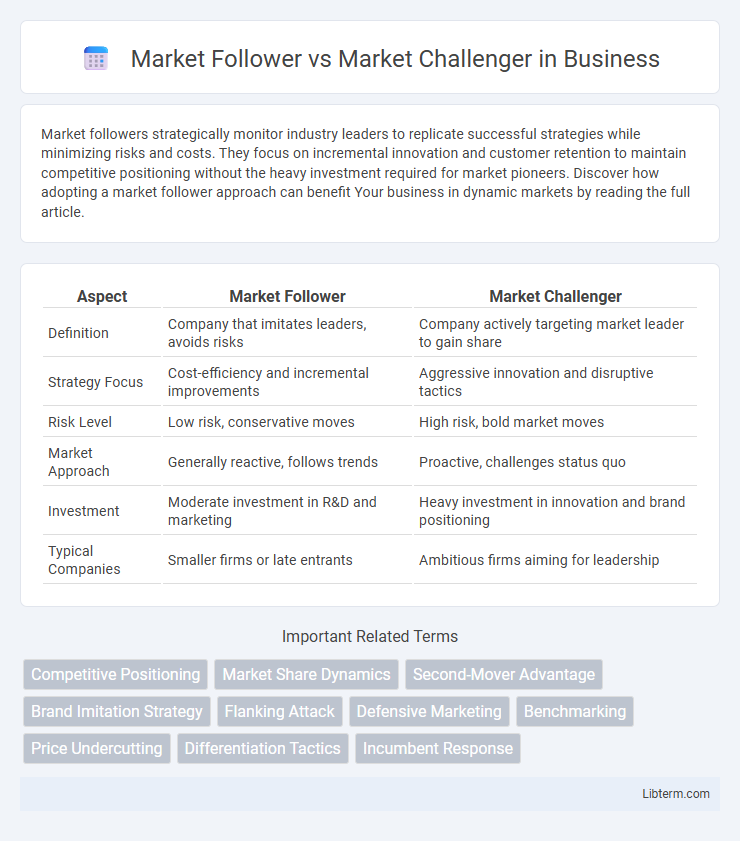Market followers strategically monitor industry leaders to replicate successful strategies while minimizing risks and costs. They focus on incremental innovation and customer retention to maintain competitive positioning without the heavy investment required for market pioneers. Discover how adopting a market follower approach can benefit Your business in dynamic markets by reading the full article.
Table of Comparison
| Aspect | Market Follower | Market Challenger |
|---|---|---|
| Definition | Company that imitates leaders, avoids risks | Company actively targeting market leader to gain share |
| Strategy Focus | Cost-efficiency and incremental improvements | Aggressive innovation and disruptive tactics |
| Risk Level | Low risk, conservative moves | High risk, bold market moves |
| Market Approach | Generally reactive, follows trends | Proactive, challenges status quo |
| Investment | Moderate investment in R&D and marketing | Heavy investment in innovation and brand positioning |
| Typical Companies | Smaller firms or late entrants | Ambitious firms aiming for leadership |
Introduction to Market Followers and Challengers
Market Followers maintain steady growth by imitating strategies of Market Leaders, leveraging existing demand with lower risk and investment in innovation. Market Challengers aggressively target market share through innovation, price competition, and promotional tactics to disrupt incumbents. Both roles strategically balance competition and stability within dynamic market landscapes.
Defining Market Follower Strategies
Market follower strategies involve carefully imitating or adapting the innovations and market approaches of market leaders to minimize risk while maintaining a stable market share. These strategies emphasize cost control, product improvement, and selective market segmentation without provoking direct competition from market challengers. Market followers prioritize incremental innovations and customer loyalty programs to sustain profitability within competitive industries.
Understanding Market Challenger Approaches
Market challengers employ aggressive strategies such as frontal attacks, which target the market leader's strengths head-on, and flanking attacks that exploit less defended market segments, to increase their market share. They also use indirect approaches like encirclement to surround competitors through multiple fronts or guerrilla tactics involving small, intermittent assaults to erode rival positions. Understanding these approaches helps businesses craft competitive responses and identify opportunities for sustainable growth in highly contested markets.
Key Differences Between Followers and Challengers
Market followers prioritize stability and incremental innovation, often imitating or slightly improving the products of market leaders to maintain steady growth. Market challengers aggressively pursue market share through innovative strategies, competitive pricing, and direct attacks on competitors' strengths, aiming to disrupt the industry status quo. Followers typically avoid risky moves, while challengers invest heavily in R&D, marketing, and expansion initiatives to quickly capture and convert customer segments.
Advantages of Being a Market Follower
Market followers benefit from lower risk as they capitalize on established market demand and proven product success, minimizing the costs associated with innovation. They gain competitive advantages by learning from pioneers' mistakes and avoiding expensive research and development pitfalls. Market followers can also allocate more resources to marketing and customer engagement, strengthening brand loyalty without the pressure of first-mover challenges.
Benefits of Adopting a Challenger Position
Adopting a market challenger position allows brands to aggressively capture market share by directly targeting the leader's weaknesses and introducing innovative product differentiators. This proactive stance fosters greater brand visibility and competitive advantage through bold marketing campaigns and disruptive pricing strategies. Challengers often achieve faster growth and enhanced customer loyalty by positioning themselves as credible alternatives to incumbent market leaders.
Common Strategies Used by Market Challengers
Market challengers commonly employ aggressive strategies such as frontal attacks targeting the market leader's strengths and flanking attacks focusing on unexploited market segments. They also use innovation-driven differentiation to introduce unique product features and pricing strategies that undercut competitors. Leveraging extensive market research and competitive intelligence helps challengers anticipate moves by leaders and adjust tactics effectively.
Risks and Challenges for Market Followers
Market followers face significant risks including limited market share growth and vulnerability to aggressive strategies from challengers and leaders. They often struggle with differentiation, leading to price wars and reduced profit margins. The challenge lies in balancing imitation with innovation to avoid being perceived merely as copycats while maintaining competitive relevance.
Case Studies: Successful Followers vs. Effective Challengers
Case studies reveal that market followers, such as Samsung in the smartphone industry, successfully leverage established innovations by refining and adapting products to capture market share without bearing pioneering risks. Market challengers like PepsiCo aggressively disrupt incumbents with bold marketing campaigns and product diversification, evidencing effective strategies to erode competitors' dominance. These examples highlight that market followers gain through incremental improvements and cost efficiency, while challengers excel through innovation-led offensives and brand repositioning.
Choosing the Right Strategy for Market Positioning
Market followers typically adopt a risk-averse strategy, emphasizing incremental innovation and cost-efficiency to maintain stable market share without provoking direct competition. Market challengers pursue aggressive tactics, such as product differentiation and targeted marketing campaigns, to disrupt incumbents and capture greater market share. Selecting the right strategy depends on the company's resources, competitive environment, and long-term growth objectives.
Market Follower Infographic

 libterm.com
libterm.com